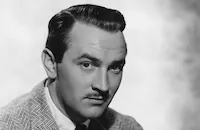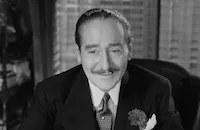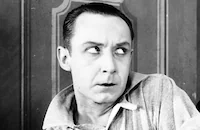My Dream Is Yours

Brief Synopsis
Cast & Crew
Michael Curtiz
Jack Carson
Doris Day
Lee Bowman
Adolph Menjou
Eve Arden
Film Details
Technical Specs

Synopsis
Popular Los Angeles radio singer Gary Mitchell's refusal to sign another contract with Felix Hofer, the sponsor of the "Enchanted Hour," angers Doug Blake, his agent. Gary offers to take Doug with him to his new program as his secretary, but Doug vows to find a new "Gary Mitchell." Doug's boss, Thomas Hutchins, begs Doug to offer Gary anything he wishes in order to convince him to sign with Hofer, but Doug quits rather than comply. In New York, Doug searches everywhere for a replacement act and is about to give up when he hears Martha Gibson, a turntable operator for a jukebox service. For singing to Doug, rather than playing a record, Martha loses her job, and so misses Doug when he hurries to the station to sign her. After a few more misses, the two finally connect and set off for California, and Martha, a war widow, is forced to leave her young son Freddie behind with her uncle Charlie. In Los Angeles, Martha auditions for Hofer, who does not like her upbeat, jazzy singing, but Gary is attracted to her and invites her to lunch. Doug is still determined to make Martha a success. He persuades Vivian Martin, Hutchins' secretary to share her apartment with Martha and then tries unsuccessfully to find her a job.
Finally, Martha gets herself a job at a nightclub, but conditions there are so bad that she quits. Later Doug flies Freddie out to California, imposing yet another roommate on the irritated Vi. When Doug hears Martha singing to Freddie, he realizes that her strength is in ballads, not jazz. To get the money to audition her again, Doug sells Vi's car and arranges for Martha to sing on the radio. His efforts are wasted, however, when Hofer fails to listen to the performance. Later, Gary invites Martha to a party which is attended by agents and sponsors. Doug sneaks in and arranges for Martha to sing, but Gary picks a fight with him, and again Martha loses the opportunity to perform. One night, a drunken Gary misses his broadcast, and Martha replaces him. This time Hofer loves her singing and fires Gary. Afterward, Martha tries to find Gary, with whom she is in love, but he has disappeared on a binge.
One night, after reading a bedtime story to Freddie, Doug proposes to Martha, who turns him down because she is still in love with Gary. After Gary returns, Doug begs Hutchins to take him back as a client, and when Hutchins refuses, arranges for him to sing at the Cocoanut Grove nightclub. He is so nervous that Martha joins him and helps him successfully complete his performance. At the end, however, Martha realizes that while Gary is selfish and egotistical, Doug is generous and loving, and she reveals that she returns Doug's love.

Director

Michael Curtiz
Cast

Jack Carson

Doris Day

Lee Bowman

Adolph Menjou

Eve Arden

S. Z. Sakall

Selena Royle

Edgar Kennedy

Sheldon Leonard

Franklin Pangborn
John Berkes
Ada Leonard
Frankie Carle
Ross Wesson
Sandra Gould
Jack Kenny

Iris Adrian

Bob Carson
Jan Kayne
Lennie Bremen

Paul Maxey

Marian Martin
Frank Scannell
Belle Daube
Louise Saraydar
Chili Williams
Patricia Northrop
Harold Gerard
Art Gilmore
Kenneth Britton
Marcel De La Brosse

James Flavin
Leo White
Tristram Coffin
Rudy Friml
Don Brodie
Edward Colman
Stanley Mann
Mary Bradley
June Whipple
Eve Whitney
Joan Lawrence
Joan Vohs
Maynard Holmes
Rodney Bell
George Neise
Chester Clute
Danny Dowling
Bridget Brown
Duncan Richardson
John Parrish
Lois Austin
Crew
George Amy
Milo Anderson
Ralph Blane
Folmar Blangsted
Gus Chandler
Wilfred M. Cline
Henry Cohen
David Curtiz
Michael Curtiz
Mort Dixon
Al Dubin
Edwin Dupar
David Forrest
I. Freleng
Robert Haas
Ernest Haller
Ray Heindorf
Natalie Kalmus
Laura Kerr
Harry Kurnitz
W. Zolley Lerner
Franz Liszt
Dane Lussier
Johnny Mercer
P. Finder Moss
Richard Mueller
George Noble
Leroy Prinz
C. A. Riggs
Allen Rivkin
Bertram Tuttle
Robert Vreeland
Jerry Wald
Harry Warren
Bert White
Howard Winterbottom

Videos
Movie Clip



Trailer
Film Details
Technical Specs

Articles
My Dream is Yours
Michael Curtiz had taken a chance on the band singer who had never acted before, and cast Day in Romance on the High Seas (1948). In her autobiography, Day recalled that Hungarian-born Curtiz, who was famous for mangling the English language, advised her early on not to take acting lessons. "I sometimes like girl who is not actress," he told her. "Is less pretend, and more heart." He told her that no matter what the role, her own strong personality would come through, and that's what makes stars. "You have natural thing there in you, should no one ever disturb." Day heeded his advice, and found that acting came as naturally to her as singing. And, in fact, she realized that she preferred acting and singing in films to singing live on radio or with a band. Even before shooting was finished on Romance on the High Seas, Curtiz realized that Doris Day would become a star, and began preparing the follow-up film, My Dream Is Yours.
A satire of the radio industry, My Dream Is Yours is a loose remake of Twenty Million Sweethearts (1934), with elements of Day's own pre-movie career as a radio and band singer. Jack Carson is a radio talent scout fed up with arrogant radio crooner Lee Bowman. Determined to create a new star, Carson meets Day, a struggling singer who spins platters for a living, and finds his next star. The strong supporting cast includes Adolphe Menjou, Eve Arden, S.Z. ("Cuddles") Sakall, and Edgar Kennedy in his final film role. Along with the sprightly songs by Al Dubin, Harry Warren, and Ralph Freed, the highlight of the film is an animated dream sequence featuring Bugs Bunny and Tweety Bird. This caused the only problem on an otherwise pleasant and uneventful production. The studio wanted the sequence to be all-animation. Curtiz fought to keep the mix of animation and live action, and won the battle.
During the making of Romance on the High Seas, Day found Carson extremely helpful, teaching her the technical tricks of movie acting, such as hitting camera marks without looking down, angling for light and camera, and sustaining an even performance through multiple takes and camera angles. Day and Carson had both recently separated from their spouses, and they began dating. The relationship continued during the filming of My Dream Is Yours. But Day found that Carson was uncommunicative and drank too much, and she wasn't ready to get into another serious relationship. After making one more film together, It's a Great Feeling (1949), they drifted apart. But she was always grateful for his professional help, and for the companionship he provided during a difficult time in her personal life.
Upon release, My Dream Is Yours earned warm, if not ecstatic notices. Typical of its reception was this review in Variety stating: "its familiar pattern of comedy and songs is pleasant enough to rate it as average, light entertainment and ticket sales should correspond." The film was no blockbuster, but it did respectable business at the box office. More important, it was another step up the career ladder for Doris Day, who would become one of the top stars of the 1950s.
Director Martin Scorsese would later cite My Dream Is Yours as a formative film experience in his book and documentary, A Personal Journey with Martin Scorsese Through American Movies: "My Dream Is Yours had all the trappings of a Doris Day vehicle produced on the Warner Bros. assembly line. It seemed to be pure escapist fare. But the comedy had a bitter edge. You saw the performers' personal relationships turning sour and being sacrificed to their careers....The film makes you aware of how difficult, if not impossible, relationships are between creative people. It was a major influence on my own musical, New York, New York. I took that tormented romance and made it the very subject of the film."
Producer/Director: Michael Curtiz
Screenplay: Harry Kurnitz, Dane Lussier, Allen Rivkin, Laura Kerr, based on the story "Hot Air," by Jerry Wald & Paul Moss
Editor: Folmar Blangsted
Cinematography: Ernest Haller, Wilfred M. Cline
Costume Design: Milo Anderson
Art Direction: Robert Haas
Music: Harry Warren
Principal Cast: Jack Carson (Doug Blake), Doris Day (Martha Gibson), Lee Bowman (Gary Mitchell), Adolphe Menjou ( Thomas Hutchins), Eve Arden (Vivian Martin), S.Z. Sakall (Felix Hofer), Edgar Kennedy (Uncle Charlie), Sheldon Leonard (Grimes), Franklin Pangborn (Sourpuss Manager).
C-102m. Closed captioning.
by Margarita Landazuri

My Dream is Yours
Quotes
Trivia
Notes
"Freddie Get Ready" was performed in a dream sequence in which Doris Day and Jack Carson were dressed in bunny costumes and interacted with animated characters from Warner Bros. cartoons. Rudy Friml, who appears in the film as an orchestra leader, was a world-famous composer. A radio version of this movie starring Jack Carson was broadcast on Lux Radio Theatre on December 26, 1949. This film is a loose remake of the 1934 Warner Bros. film Twenty Million Sweethearts, which starred Dick Powell and Pat O'Brien and was directed by Ray Enright (see AFI Catalog of Feature Films, 1931-40; F3.4796). In a 1995 BBC television documentary, director Martin Scorsese discussed My Dream Is Yours at length and noted that its central story of a relationship that breaks up because of two competitive show business careers greatly influenced his 1977 film New York, New York.















